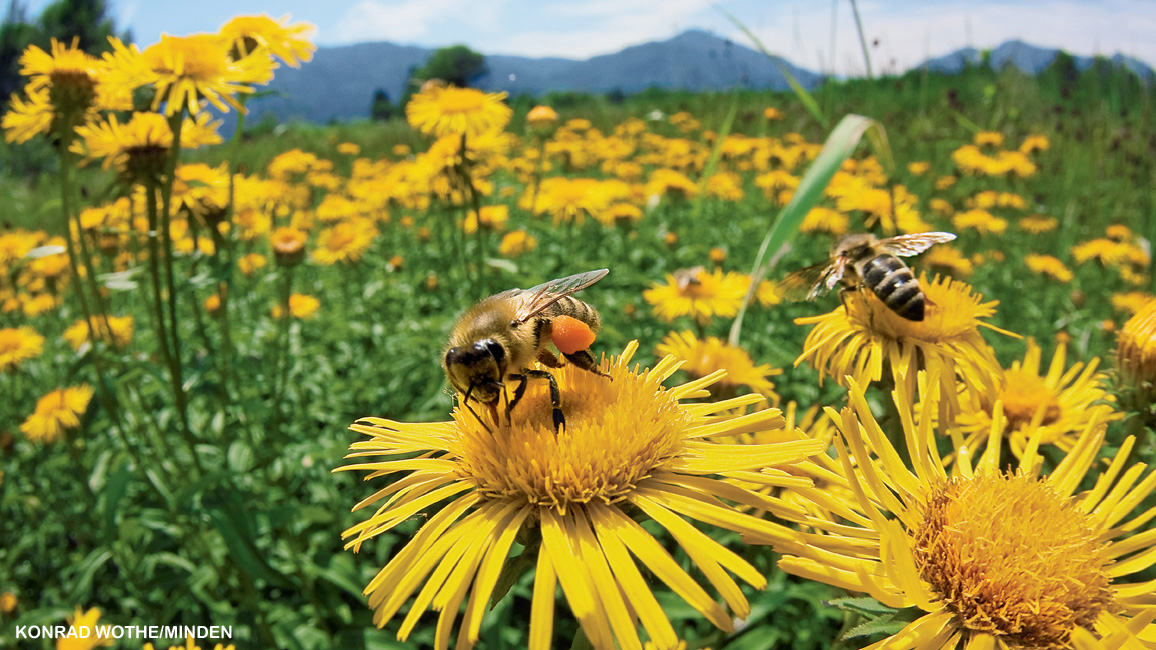
Busy, Buzzy Bees
By by Ellen Lambeth; art by John Dawson“Busy as a bee” is more than just a saying. As you’ll soon discover, honey bees have a lot going on.

Think of what might be on your dinner plate. Of every three bites you take, one probably comes with a little help from honey bees. That’s because these bees pollinate the flowers of many plants that people grow for food. (See “Pollination Explanation” below.) These crops include apples and almonds, beans and broccoli, cucumbers and cherries, and so much more. So, every time you eat a meal, you can thank a bee!
Honey bees don’t pollinate just food crops for people. The ones above, for example, are doing their part to keep this field alive with colorful flowers. Keep reading to find out what they’re so busy doing.
FUN FACT: A bee’s buzz is the sound of its wings flapping 200 times per second.
Pollination Explanation
A bee travels to a flower to collect its sweet nectar. As it does, sticky grains of pollen get caught on its hairy body. The bee then visits other flowers of the same kind, where some of the pollen grains rub off. The pollen fertilizes the other flowers, which causes them to make seeds. Some of these seeds then grow into new plants.

Hive Alive!
A hive buzzes with activity. It’s where honey bees live, store food, and raise their young. Here’s an inside look!
Drone
Male bee. Drones don’t have stingers. Their job is to mate with the queen.
Queen
Each colony has one queen. Her job is to lay eggs—up to 2,500 a day!
Honeycomb
Worker bees build it out of wax that they produce in their bodies. They form the wax into little spaces called cells. Some cells are for raising young. Other cells are used to store honey (made from nectar) and pollen. The pollen is for baby food. The honey is the bees’ winter food supply.
Worker
Female bee. Most of the bees in a hive are workers.
Waggle Dance
When a collector bee finds a good source of nectar and pollen, she returns to the hive and tells other collectors about it. How? By dancing! The bee in the center of the photo above is doing the waggle dance. Other bees gather round to watch.
WATCH HONEY BEES PERFORM A WAGGLE DANCE!
During the dance, the bee moves in a figure-8 pattern with a “waggle” up the middle (see diagram). The path she takes tells where the food supply is in relation to the sun. The waggle part tells how far away it is.
Life of Labor
Worker bees have many different jobs. Here are some of them:
- Collector bees gather nectar or pollen from flowers.
- Transfer bees take nectar or pollen from the collectors and put it in cells.
- Guard bees keep out (or remove) intruders.
- Nurse bees take care of the eggs, larvae (LAR-vee, young), and queen.
- Builder bees produce wax to make the comb and to cap cells with honey or developing young.
- Housekeeper bees clean and repair the honeycomb.
- Fan bees beat their wings to control the hive’s temperature and humidity.
FUN FACT: A colony may have 20,000 to 60,000 bees.

Bees and You
Bees make life a lot more livable for both plants and animals (including people).
It takes two million flower visits to make one pound of honey.
Un-BEE-lievable Gifts
Animals such as badgers and bears have a sweet tooth for honey. And so do people! Beekeepers are people who raise honey bees and harvest the honey to sell. Some also sell beeswax, which can be made into products such as lip balm, candles, or polishes.
Case of the Missing Bees
About 10 years ago, beekeepers started finding hives without honey bees. No one was sure what the problem was. Scientists figured out that it was a combination of problems, including chemicals sprayed on plants, bee pests (such as those red-colored mites on the backs of the bees), and diseases. People have been working hard to help save these important pollinators.
Our Bees
You may know honey bees best. Early settlers from Europe brought them to America, where they’re now found far and wide. But there are many other kinds of bees—about 4,000 species—that are native to (naturally belong in) the United States alone. Like honey bees, some are social bees. That means they live and work together as a colony in one big nest. But most are solitary bees, which make and live in individual nests. Both social and solitary bees are important pollinators. Here are just a few:
Bumble Bee
Like the honey bee, is social. Is big, round, and very fuzzy.
Carpenter Bee
Looks a lot like a bumble bee. Gets its name because it often carves into wood to make its nest.
Mason Bee
Named for its habit of using mud to build little rooms in its nest hole.
Leafcutter Bee
Chews off bits of leaves and uses them to “wallpaper” its nest.
Honey bees have an amazing sense of smell.
Bee Friendly!
Because bees do so much for the environment and for people, why not return the favor? Here’s how to make your yard THE place to BEE:
- Plant bee-friendly flowers. Choose ones that are native to your area. Also plant ones that bloom at different times to provide bee food all season long.
- Don’t use chemical pesticides.
- Leave some bare ground and dead wood for nesting places.
- If you see a swarm, don’t panic. Call a beekeeper to come and relocate the bees.
- Put up a bee house.
















